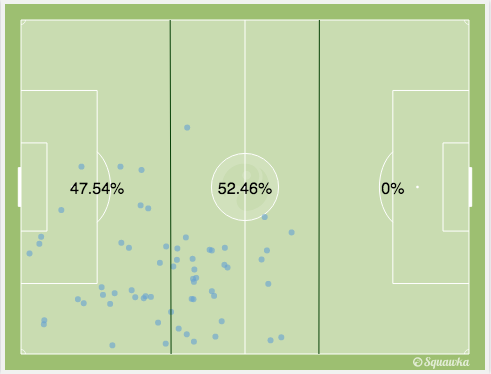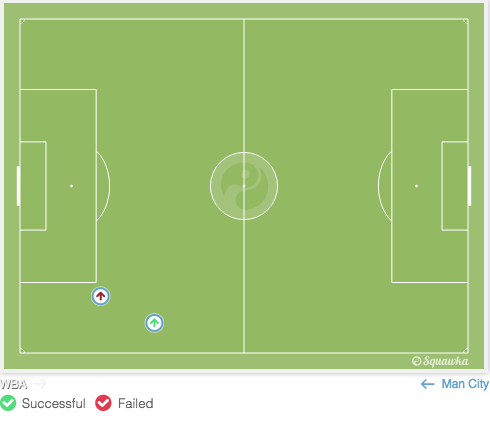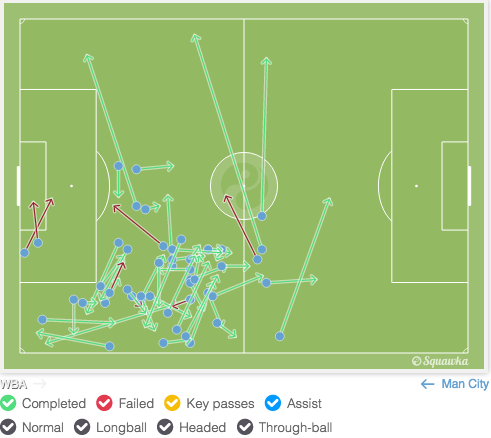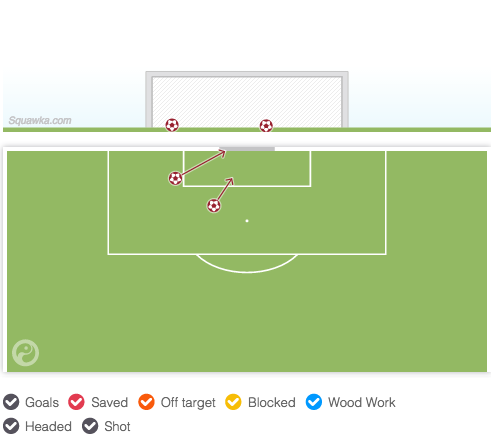Nathan Bliss analyses Raheem Sterling’s Premier League debut in Manchester City colours in the match against West Brom this past Monday.

In undoubtedly the most one-sided game of the first round of Premier League fixtures, Manchester City barely broke a sweat as they beat West Brom at The Hawthorns. Pellegrini’s men strolled to a 3-0 victory courtesy of goals from a rather fortunate Yaya Toure strike, a magnificent Yaya Toure strike and the shoulder of Vincent Kompany. Of all the players on show on Monday night though, there was one player in particular that I watched with a bit more interest. Raheem Sterling made his competitive debut for his new club Manchester City, but how did the £49 million signing perform? After watching the game live and then analysing the plethora of stats available, here’s my take on his performance.
Manchester City lined up with a 4-2-3-1 formation, with Raheem Sterling starting on the left hand side of three attacking midfielders, with David Silva and Jesus Navas filling the other two positions. Below is a graphic showing the average positions of the Manchester City players.

Average Player positions

Sterling: Average position heat map
After analysis of his positioning during the game, it’s easy to notice that Sterling’s position during the game was strangely deep. 52.46% of Sterling’s touches were actually in the middle third of the pitch, with 47.54% in the opponent’s final third. If you compare this with his performance for Liverpool versus West Brom at The Hawthorns last season, there’s a remarkable difference. In that game, 68.33% of Sterling’s touches were in the final third. Is this due to the player’s movement? Is it simply the different tactics that Manchester City employ? Time will tell over the course of the season but the stats show that Sterling was noticeably further away from the oppositions goal on Monday night than he was against West Brom for Liverpool last season.

Sterling: Touches by thirds

Sterling: Touches
When you think of what Sterling will bring to Manchester City, you immediately think of that raw attacking flair, taking on players, both creating and scoring goals. What we witnessed last night, whether it was first game nerves or just not yet having an understanding with his teammates, by his usual high standards it was a cautious performance. As you can see from the graphic below, Sterling attempted just two take ons in the whole game, completing only one. These take ons where attempted within the opening 10 minutes of the game, with no more attempted in the next 60 minutes he was on the pitch.

Sterling: Take ons
It’s worth taking into account that West Brom were sitting very deep with 10 men behind the ball, dropping off and not applying much pressure to the players in possession, making it more difficult to beat individuals by take ons. However, if we again look at Sterling’s performance for Liverpool against West Brom at The Hawthorns last season, ‘the baggies’ lined up with a very similar 4-4-1-1 formation with similar tactics and Sterling managed to attempt 6 take ons. You could argue that its due to the differing style of play that Manchester City employ but the stats don’t lie. Sterling was brought in to attack the opposition and commit defenders, to do this just twice in the entire game is unlike Sterling and is certainly not playing to his strengths.

Sterling: Take ons for Liverpool last season vs West Brom
It’s the same story with his distribution, the record breaking Englishman completed 50 passes and of those, 46 were short passes with an overall 86% pass completion rate. Not bad, but these stats don’t tell the whole story, of all the Manchester City players, only Joe Hart and Aleksander Kolarov had a worse pass completion rate. Crucially though, if we look at key passes, passes that lead to chances, assists or goals, Raheem Sterling didn’t attempt a single key pass in the 73 minutes he was on the pitch. Then there’s his crossing, in the entire game Sterling attempted only one cross into the West Brom area and it was unsuccessful. So he didn’t commit defenders, he didn’t create chances and he was too safe with his passing, but what about his shooting?

Sterling: Passes

Sterling: Crosses
On 42 minutes, James McClean loses the ball in the middle of the pitch and immediately Fernandinho wins the ball, looks up and sees a magnificent run from Sterling. Surging past debutant James Chester, Sterling is clean through on goal with just Boaz Myhill to beat, at this point you would think a player that cost £49 million pounds, an English transfer record, would be able to easily stroke the ball into the corner of the net and its truly game over. In reality, the Manchester City number 7 produced a tame effort, straight at the goalkeeper and it was easily cleared. Over the course of 90 minutes, that shot was one of just 2 from Sterling, both of which were easily saved.

Sterling: Shots
Raheem Sterling is the most expensive English player in history, costing £49 million pounds. Therefore, it would be easy to criticise his performance, it would be easy to say that he has to do better. What Manchester City fans have to understand though, is that they have spent £49 million pounds on pure potential and Sterling is by no means world class (yet) or the finished article. This is a really unique and somewhat strange situation, as teams ordinarily spend that amount of money on a proven, world class player, someone who can come straight into the team and perform at the highest level. Sterling is 20 years old and at that age he can’t be expected to finish every chance, to assist in every game or to beat his man every time. What you can expect, to a certain extent, is for Sterling to improve as the season goes on, in the coming seasons and could even go on to become a world class player at some point in the future.
Yes, it was a underwhelming debut overall for Raheem Sterling, he didn’t create any chances, he didn’t take on enough players and he failed to score, even though he had a great chance. Sterling will undoubtedly frustrate at times, as he has tonight, but as with any young player, he can also be electrifying and his potential is frightening. He will be inconsistent, as most young players are at his age, what is imperative for his development though is that he’s shown patience when things aren’t going so well and is given time to improve. If he’s given that time, in a couple of years England and Manchester City might have a world class player in their ranks, but he’s not there yet.
PREVIOUS ARTICLE
Written by Nathan Bliss
- Analysis: How did Gareth Bale perform against Betis? - September 3, 2015
- Why Bojan is finally fulfilling his undoubted potential - August 14, 2015
- Analysis: How did Raheem Sterling perform against West Brom? - August 12, 2015




























































